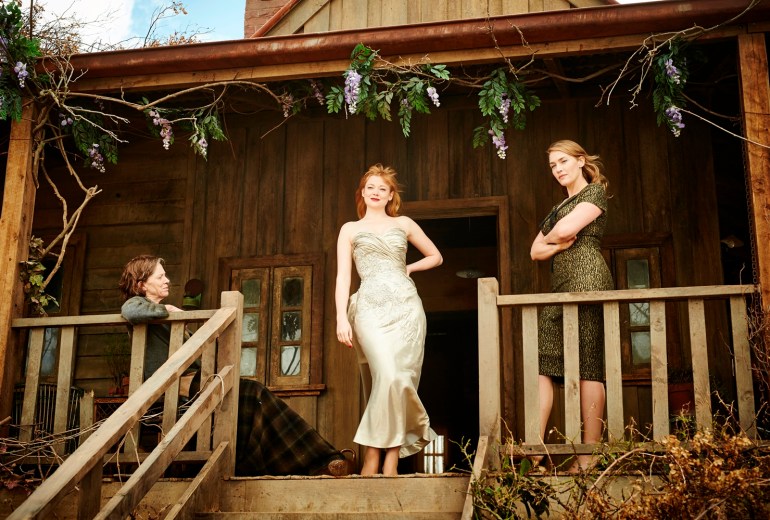‘The Dressmaker’.
Sue Maslin spent five years developing the script of The Dressmaker, earning just $14,000 in producer fees on the project during that time.
Before she had raised the finance for the lyrical comedy-drama directed and co-written by Jocelyn Moorhouse, the project was in significant debt.
Although the film starring Kate Winslet, Judy Davis, Liam Hemsworth and Hugo Weaving was a hit and has delivered returns for investors, Maslin is among many producers who are calling on funding agencies to include meaningful producer fees in development budgets.
Maslin outlined her case after Film Victoria CEO Jenni Tosi told last week’s 2020 Vision | Feature Film Forum on development that, too often, creative teams feel compelled for financial reasons to start production on films knowing the script is still not quite there.
“I agree about not rushing into production until your script is pitch perfect but the agencies must recognise that unless you have Enterprise support (I never have), there is almost no support for producers to do this,” Maslin tells IF.
“The solution in my view is to recognise producer fees as legitimate costs of bringing a film to market and for the screen agencies to allow these costs to be included realistically in a development budget.”

Screen Producers Australia CEO Matt Deaner supports that view, telling IF: “As the feature film market has gotten tighter and the potential for any upside for producers has deteriorated, we really do need to re-evaluate and re-think the support we are providing feature film producers both during development and in the structure of deals that can offer opportunities for return.
“Otherwise we are removing the incentives for businesses to operate in what is already an incredibly difficult market.
“Producers do the painstaking, agonisingly slow but necessary work over many years of shepherding and developing multiple projects without income streams, and the risk they take doing this must be recognised and rewarded appropriately. Re-looking at development budgets and how to encourage thorough and careful collaboration throughout the gestation of a film is a good start.”
Maslin said the situation she faced during development of The Dressmaker was the norm for feature producers, declaring: “We need to change this if we don’t want to see more features go into production prematurely and disappoint at the box office.
“There is no question that financing feature films is a risky business given the high failure rate. The producer, the person who takes the greatest risk at the development and financing stage, is remunerated the least during this period and the temptation to rush into production is high as ballooning personal debt can be crushing.
“Added to this problem is that producer risk is not necessarily offset by reward. This is because opportunity cost to the producer is reflected in finance plan as deemed ‘producer equity’ which is worthless unless there are significant returns at the other end. The producer margin is no buffer as it is almost always traded away by the producer to close the critical gap between the budgeted cost of the film and the available finance.”
Maslin, who is developing historical drama The Variations with Moorhouse and psychological drama The Lost Swimmer with writer Ann Turner, estimates that for most Australian features there is a return of only around 10 per cent of gross BO revenues, so the producer’s share in minimal.
Ten years ago when the Producer Offsets were introduced there was an upside from home entertainment and TV rights, which has largely been eroded.
In its review of the Producer Offset, Screen Australia reported that 37 per cent of feature producers had traded their Offset equity. However 86 per cent said they had retained at least half and 45 per indicated they had only traded a small amount.
Maslin asserts: “The real question for feature film producers is not what percentage of equity they have retained but how much income they have derived from their share of equity? What is the average? What percentage of feature producers over 10 years have derived meaningful revenue from their equity share?”
She concluded: “Equity in a film like The Dressmaker [which grossed $20.28 million in Oz] has delivered returns and I am grateful for the PO as it has enabled us to develop our business and slate. What of the vast majority of Australian films that earn less than $5 million at the box office?
Screen Australia points out its report showed 90 per cent of production companies stated the Offsets had increased their revenue and 36 per cent said that increase was significant.
The report also showed companies are earning more revenue since the introduction of the Offset and there are fewer companies earning revenues of less than $500,000.
Deaner advocates a rethink of the way the offsets operate, arguing: “There are structural issues in both the television and feature film markets that conspire against producers who are being coerced into trading away equity in projects, margins they may make on deals and as a consequence any potential upsides to their businesses and their own financial health.
“This in turn limits the investment in our industry of the development of new works – particularly in our creative talent and in so doing prevents sustainable work practices from maturing.
“Clearly it is the power dynamics between the different participants that are heightened in the current tightening market that lead us to this outcome. The absence of a deep understanding of the realities facing small businesses and the lack of attention given to these issues is an ongoing and deeply disturbing concern.”
IF intends to file a story on Screen Australia’s response after CEO Graeme Mason returns from Content London.



